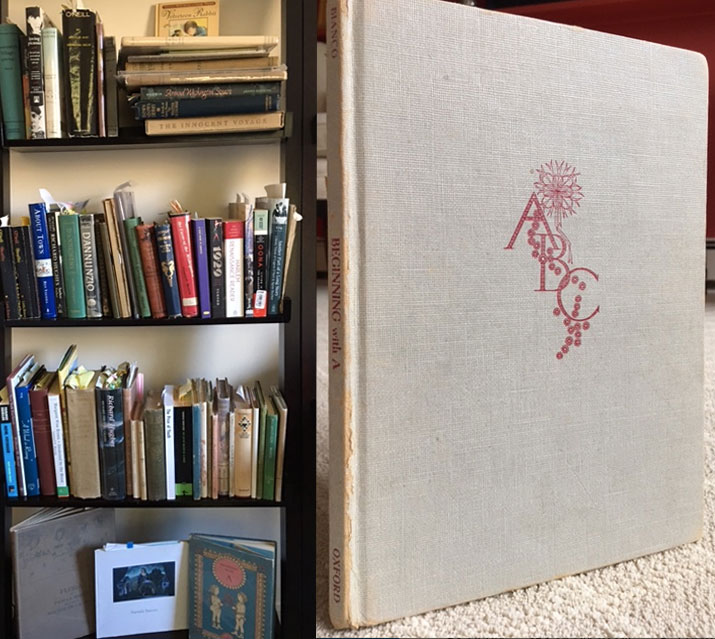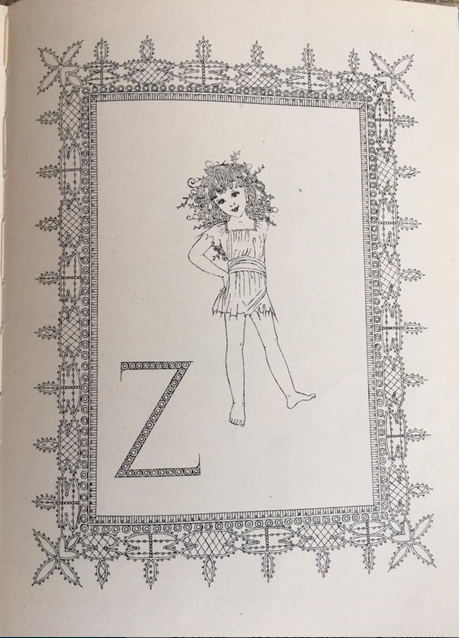 I happened upon Pamela Bianco one June morning of 2006 during a prolonged fit of procrastination. Avoiding the computer, I went to the bookshelf that held my well-loved books from childhood. I pulled out an ancient favorite—a thin, gray volume, its dust jacket lost long ago. The cover was stamped in red ink with an ABC design. I had always been entranced by the pen and ink drawings: twenty-six children, Alexander to Zita. A six-line verse accompanied each child, and each was surrounded by a beautifully ornate frame of various mixtures of flowers, bows, diamonds, lace, and geometric patterns. When I turned the pages I felt as if I were looking at a show of snowflakes.
I happened upon Pamela Bianco one June morning of 2006 during a prolonged fit of procrastination. Avoiding the computer, I went to the bookshelf that held my well-loved books from childhood. I pulled out an ancient favorite—a thin, gray volume, its dust jacket lost long ago. The cover was stamped in red ink with an ABC design. I had always been entranced by the pen and ink drawings: twenty-six children, Alexander to Zita. A six-line verse accompanied each child, and each was surrounded by a beautifully ornate frame of various mixtures of flowers, bows, diamonds, lace, and geometric patterns. When I turned the pages I felt as if I were looking at a show of snowflakes.
Inside the finely worked frames simple line drawings of the children floated in white space. The verses brought them to life. “O” is for Oliver, who can make me sad even now. He stands in his frame with his hands out at his sides as if he simply doesn’t know what to do. His shoes are mismatched; his socks are mismatched. He is wearing a jacket that is torn and buttoned all wrong. Safety pins are everywhere – trails of linked pins hang from his sleeve and from his shorts and a pile of pins lies on the ground.
I’m Oliver. I wonder why
My Daddy gives a great big sigh
Each time I say, “Where is Mama?
Will she come soon? Did she go far?”
She left us both so long ago;
I don’t remember her, do you?
My favorite child was the last one in the book – Zita. She wears a simple, tattered dress. She is barefoot, and has lightning-jagged hair.

I’m Zita, just a gipsy lass.
They found me on a mountain pass.
Day in day out I wandered there
With thorns and catkins in my hair;
They hunted for me day and night
And rescued me with lanterns bright!
Twenty-six children. Twenty-six stories. How many hundreds of times had I thumbed through that book? When I picked up the alphabet book that morning it was the first time in half a century that I became curious about the author. Who was it who had charmed me for all these years? I turned to the front of the book. The author and illustrator was Pamela Bianco.
Pamela Bianco. I wondered if she had published other books. My curiosity piqued, I went to the computer and Googled her name. Another bit of procrastination, I thought.
It took only a click on the first site to get my attention. “Keith Sheridan Fine Prints” showed three back and white images, lithographs by “Pamela Bianco – b. 1906.” I was immediately struck by the opening sentences of a brief biography that accompanied the artwork: “Pamela Bianco’s career as an artist began at the age of twelve when her first exhibit at Leicester Galleries, London, brought the child prodigy to international recognition. Following the show, Walter de la Mare composed a series of poems entitled Flora to accompany a suite of her drawings.”
Child prodigy? Exhibited at twelve?
I looked again at the lithographs. Fruit Piece was a drawing of two fruits – apples? peaches? – on a plate with two walnuts and what looked like large olives, or small plums. Untitled (Summer Reflections) revealed a thick, knobby tree trunk growing out of rock. And Primula depicted a potted plant by an open window, three of its large leaves leaping out at the viewer. These images were bold, heavy; they had little in common with the dainty, airy drawings in my alphabet book. The first lithograph was dated ca. 1925, the other two ca. 1930. Pamela would have been between eighteen and twenty-three years old.
A few minutes’ scrolling through search results revealed that Pamela Bianco had published many children’s books in the 1940’s and 50’s. I picked up Beginning With A again. It was published in 1947. She would have been forty-one. What had happened? Had she given up her “serious” art and turned to writing and illustrating children’s books later in life? If so, why?
And, most important, who was she?
I dug in. I did the research. But strangely enough, the connection is so unknown, so buried, that it took me almost a year before I discovered that Pamela’s mother was Margery Williams Bianco, the woman who wrote The Velveteen Rabbit. Now this was news, indeed. The story of Pamela that so intrigued me became suddenly doubly amazing.
And so my obsession began. From places far and wide—the New Yorker archives buried deep in the New York Public Library; an art gallery catalogue in London; letters (handled with white-gloved hands) at the Lilly Library in Bloomington, Indiana; an antiquarian book dealer in Carmel, California—I collected the disparate pieces of the puzzle. Now joined as best as I know how, they have formed the portrait that is The Velveteen Daughter.